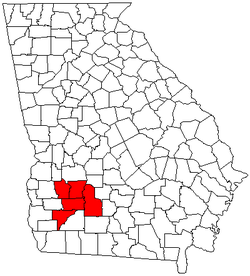Albany metropolitan area | |
|---|---|
| Albany metropolitan statistical area | |
 Dougherty Judicial Building | |
 Albany MSA highlighted in red | |
| Coordinates: 31°40′N 84°7′W / 31.667°N 84.117°W | |
| Country | United States |
| State(s) | Georgia |
| Largest city | Albany |
| Area | |
| • Total | 1,591 sq mi (4,120 km2) |
| Population (2023) | |
| • Total | 145,508 |
| • Density | 92/sq mi (36/km2) |
| Time zone | UTC−5 (EST) |
| Area code | 229 |
The Albany metropolitan area, officially the Albany metropolitan statistical area, as defined by the United States Census Bureau and U.S. Office of Management and Budget, is a metropolitan statistical area consisting of five counties in the U.S. state of Georgia: Baker, Dougherty, Lee, Terrell, and Worth. Located in within the region of Southwest Georgia, the metropolitan area had a 2023 census-estimated population of 145,508.[1]
Geography[edit]
The Albany MSA is located in southern Georgia, and consists of the following counties: Baker, Dougherty, Lee, Terrell, and Worth.
Communities[edit]
Places with more than 10,000 inhabitants[edit]
Places with 1,000 to 10,000 inhabitants[edit]
Places with 500 to 1,000 inhabitants[edit]
Places with less than 500 inhabitants[edit]
Unincorporated communities[edit]
Demographics[edit]
According to the 2000 United States census,[2] there were 157,833 people, 57,403 households, and 41,206 families residing within the MSA. In 2020, the Albany metropolitan area had a population of 148,922, although at the 2022 U.S. census estimates, its resident population declined to 146,387.[1]
In 2000, the racial makeup of the MSA was 49.33% White, 48.66% African American, 0.25% Native American, 0.54% Asian, 0.02% Pacific Islander, 0.50% from other races, and 0.70% from two or more races. Hispanic or Latinos of any race were 1.32% of the population. In 2022, the American Community Survey estimated its racial composition was 39% White, 52% African American, 1% Asian, 3% two or more races, and 3% Hispanic or Latino of any race.[3] While its population declined from 2000 to 2020, its demographic makeup followed nationwide trends of greater diversification, and the growth of the Hispanic or Latino American community.[4][5] Historically, the MSA has been considered part of the Black Belt in the American South.
In 2000, the median income for a household in the MSA was $33,845, and the median income for a family was $39,361. Males had a median income of $31,094 versus $21,055 for females. The per capita income for the MSA was $16,652. By 2022, its median household income was $48,376 with a per capita income of $26,045. An estimated 26.2% of the population lived at or below the poverty line. Among the metropolitan population in 2022, 28% earned from $50,000-$100,000 annually, and the median value of an owner-occupied housing unit was $141,700.[3]
Transportation[edit]
Air[edit]
Highways[edit]
See also[edit]
References[edit]
- ^ a b "Metropolitan and Micropolitan Statistical Areas Population Totals: 2020-2022". U.S. Census Bureau. Retrieved 2024-01-30.
- ^ "U.S. Census website". United States Census Bureau. Retrieved 2008-01-31.
- ^ a b "Census profile: Albany, GA Metro Area". Census Reporter. Retrieved 2023-12-28.
- ^ "The Chance That Two People Chosen at Random Are of Different Race or Ethnicity Groups Has Increased Since 2010". Census.gov. Retrieved 2023-12-29.
- ^ "New 2020 census results show increased diversity countering decade-long declines in America's white and youth populations". Brookings. Retrieved 2023-12-29.